
Учебное пособие 800637
.pdf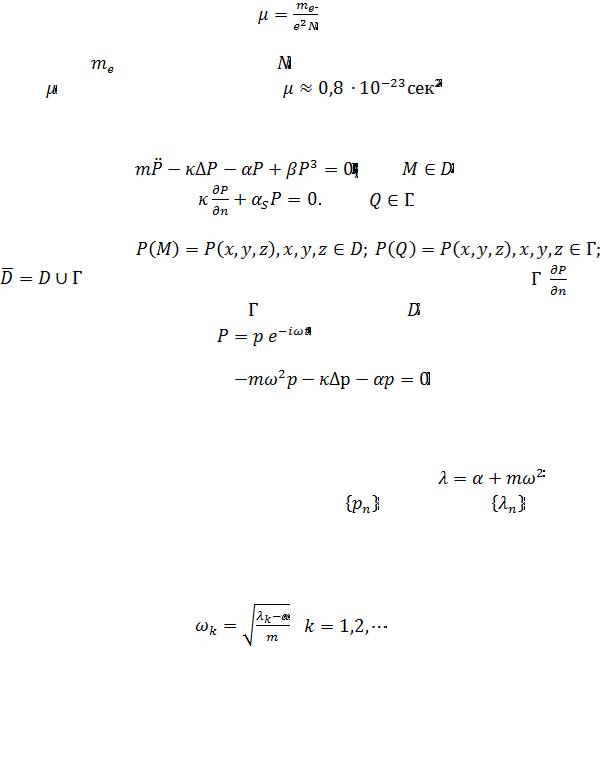
ing the order parameter at the border [2]. The integration is taken over the volume  and the surface
and the surface  of the ferroelectric particle.
of the ferroelectric particle.
The mass coefficient  for polarization oscillations is estimated as
for polarization oscillations is estimated as
|
|
, |
(2) |
where |
is the mass of unit cell, |
is the number of cells per unit volume. Evalua- |
|
tion of for TGS (triglycine sulfate) gives: |
|
[3]. |
|
Varying expression (1), we obtain an equation describing the oscillations of a ferroelectric nanoparticle, and the boundary condition to it:
|
|
(2) |
|
|
(3) |
where |
|
|
is the area of the space occupied by the nanoparticle, with the border ; |
is the |
|
derivative of the normal to the surface |
, external to the region . |
|
For stationary oscillations |
the equation (2) takes the form: |
|
|
. |
(4) |
The boundary condition (3) does not change.
The problem of finding the oscillation spectrum of ferroelectric inclusions in a nanocomposite is posed as an eigenvalue problem.
Equation (4) is the eigenvalue equations for the parameter |
. Solving |
|
problem (3) - (4) we obtain the set of eigenfunctions |
and eigenvalues |
. The lowest |
eigenvalue  corresponds to the phase transition and determines the phase transition temperature shift. Higher eigenvalues determine the eigenfrequencies
corresponds to the phase transition and determines the phase transition temperature shift. Higher eigenvalues determine the eigenfrequencies  of the nanoparticle oscillations::
of the nanoparticle oscillations::
, |
(5) |
The eigenfrequencies  depend on the temperature according to (5), on the size and shape of nanoparticles. A ferroelectric particle of elliptical shape and particles of the simplest geometries (spherical, cylindrical forms) are considered in the work. For particles of spherical, cylindrical and parallelepiped-shaped, the solution can be obtained in general form through Bessel functions. The spectrum of oscillations is analyzed depending on the size, shape of particles, and boundary conditions for polarization.
depend on the temperature according to (5), on the size and shape of nanoparticles. A ferroelectric particle of elliptical shape and particles of the simplest geometries (spherical, cylindrical forms) are considered in the work. For particles of spherical, cylindrical and parallelepiped-shaped, the solution can be obtained in general form through Bessel functions. The spectrum of oscillations is analyzed depending on the size, shape of particles, and boundary conditions for polarization.
Referenses
1. Vaks V.G. Introduction to the microscopic theory of ferroelectricity. - M.: Nauka, 1973. - 327 p. (in Russian).
70

2.Nechaev V.N. On the parameters determining the special features of phase transitions in composite materials / V.N. Nechaev, A.V. Shuba and A.V. Viskovatykh // Russian Physics Journal, Consultants Bureau. – 2015.
-V. 58. - № 5 – P. 114–118.
3.Jonah F., Shirane D. Ferroelectric crystals, trans. from english - M.: Mir, 1965. 555 p. (in Russian).
UDC 537.228.1
THE RELIEF SHAPE CHANGING OF THE CRYSTAL Rb2ZnCl4 ELECTRICAL ENERGY DEPENDENCE FROM POLARIZATION IN THE DOMAIN STRUCTURE FREEZING TEMPERATURE VICINITY (T* 150 K)
V. V. Gorbatenko1, B. N. Prasolov2, S. A. Gorbatenko3, N. V. Datsenko4 1Candidate of physical and mathematical sciences, associate professor, vlgorbatenko@mail.ru
Voronezh state technical university
2Doctor of physical and mathematical sciences, professor, vlgorbatenko@mail.ru Investments and technologies LLC, Voronezh, Russia
3Doctor of technical sciences, professor, sv_gorbatenko @mail.ru Voronezh state institute of physical culture
4Candidate of technical sciences, associate professor, natdatsenko@mail.ru Voronezh state university of engineering technologies
The group 2 4model crystal - chlorzincate rubidium Rb2ZnCl4 repolarization process under the harmonic electric field action with the amplitude above the coercive field intensity in the domain structure freezing temperature vicinity (T* 150 K) by the harmonic analysis method was investigated.
The study of the current density harmonics that arising in the sample under the harmonic field action allowed constructing the sample volume unit electric energy Wc dependence on the polarization
Pc measured in the dynamics. It is shown that in a relatively small temperature range in the T*vicinity there is a significant dependence Wc (Pc ) potential relief shape change.
Keywords: polarization, phase transition, incommensurate phase, ferroelectrics.
It is known that the behavior of dielectric and polarization Rb2ZnCl4 crystal properties in the ferroelectric phase in the temperature range from the Curie point TC to T* 150 K is determined by the dynamics of ferroelectric domain boundaries as solitons, and their contributions values significantly depend on the crystal background and in particular on the temperature and samples holding time in the paraelectric and incommensurate phases [1,2].Structural changes like phase transition in the domain wall are observed in Rb2ZnCl4 in the vicinity of T* 150 K [3, 4], accompanied by a change of the domain wall width. The domain wall width decrease results to a sharp decrease in its mobility due to increased interaction with lattice defects, which is accompanied by the coercive field sharp increase with a small polarization change [5].
In order to remove the soliton structure dynamic contribution to the crystal dielectric and polarization properties the experiment was carried out as follows. First, the sample was cooled below T* by 20 K, where, as was established in [2], the soliton structure disappears almost completely, and thenthe sample was heated to 151 K. Thepolarization harmonics and current density components measurements at the sinusoidal electric field amplitudes Em
above the coercive one that was applied to the test sample at itsisothermal exposure in the temperature range from 151 K to 159 K were carried out. The study of the current density harmonics that arising in the sample under the harmonic field action allowed constructing the sample volume unit electric energy Wc dependence on the polarization Pc measured in the
dynamics. The dependence Wc (Pc ) measured at the test sample isothermal exposure at a temperature T=159 K and application to the test sample plates harmonic electric field with
V/m and frequency f0 =0.3 Hz shown in Fig.
71
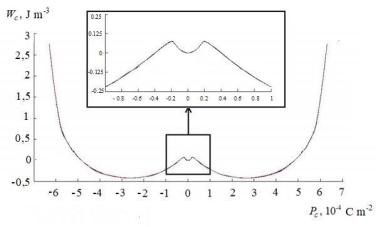
Figure. Dependences of thetest sample volume unit electrical energy Wc on its polarization Pc constructed by means of harmonic analysis
It is found that in a relatively small temperature range in the T* vicinity there is a significant dependence Wc (Pc ) potential relief shape change.
References
1.Gridnev S. A. Relaxation of long-lived metastable states in the ferroelectric Rb2ZnCl4 with a incommensurate phase / S.A. Gridnev, V.V. Gorbatenko, B.N. Prasolov // Crystallography. 1994. Vol. 39. P. 106-113.
2.Gridnev S. A. Soliton and domain contributions to non-equilibrium dielectric permittivity in Rb2ZnCl4 / S.A. Gridnev, B.N. Prasolov, V.V. Gorbatenko, FIZ. 1990. Vol. 32. No. 7.P. 2171.
3.S wanda S. Ferroelectricity in Rb2ZnCl4 / S. S wanda, Y. Shroishi, A. Yamamoto, M. a- kashige, M. Matsuo // J. h s. Soc Japan. 1977. V.43. P.2099-2100.
4.Levstic A. The interaction potential between discommensurations in Rb2ZnCl4 /Levstic A.,
Unruh .-G. // Ferroelectrics, 1988. V.78. P.173-182.
5. Gridnev S. A. On the phase transition in the domain wall in Rb2ZnCl4 near 150K / S.A. Gridnev, V.V. Gorbatenko, B.N. Prasolov // Crystallography. 1997. Vol. 42. No. 4. P. 730-734.
UDC 537.228.1
THE CRYSTAL Rb2ZnCl4 ELECTRIC ENERGY TEMPORAL EVOLUTION AS A FUNCTION OF POLARIZATION IN THE FERROELECTRIC PHASE NEAR THE CURIE POINT
V. V. Gorbatenko1, B. N. Prasolov2, S. A. Gorbatenko3, N. V. Datsenko4 1Candidate of physical and mathematical sciences, associate professor, vlgorbatenko@mail.ru
Voronezh state technical university
2Doctor of physical and mathematical sciences, professor, vlgorbatenko@mail.ru Investments and technologies LLC, Voronezh, Russia
3Doctor of technical sciences, professor, sv_gorbatenko @mail.ru Voronezh state institute of physical culture
4Candidate of technical sciences, associate professor, natdatsenko@mail.ru Voronezh state university of engineering technologies
The group 2 4 model crystal - chlorzincate rubidium Rb2ZnCl4 repolarization process under the harmonic electric field action with the amplitude above the coercive field ( Ek ) in the ferroelectric phase (FF) near the ferroelectric phase transition temperature Tc was researched by the harmonic analysis method. The current density harmonics study arising in the sample under the harmonic field action allowed constructing the sample unit volume electric energy Wc dependence on the polarization Pc measured in the dynamics. The dielectric hysteresis loops time evolution after exposure of
72

an alternating electric field E with a frequency about 20 kHz and an amplitude higher than Ek in the FF near Tc to the sample was studied in detail by the harmonic analysis method. The temporal evolution of the dependence Wc (Pc ) after exposure to the sample E was obtained. It is established that there is a significant change of the dependence Wc (Pc ) potential relief shape during relaxation.
Keywords: polarization, phase transition, coercive field, electric energy, ferroelectrics.
On the base of Rb2ZnCl4 crystal samples dielectric and polarization studies it was shown [1] that relaxation of nonequilibrium dielectric permittivity ( εk ) above the ferroelectric phase transition temperature ( Tc 199.4 K) is associated with the ferroelectric domain boundaries (DB) detachment from the stoppers and the subsequent domain structure disappearance in a incommensurate phase. There is a peak of dependence εx (T) recorded during the test sample heating at Tc temperature. It is noteworthy that in equilibrium conditions in the Tc vicinity in FF there is a temperature-independent behavior of Ek obtained after dielectric hysteresis loops processing measured at a frequency of 0.3 Hz. In [2] it is shown that Ek =Ec +E0 where Ec - the field strength due to losses occurring in the sample, and E0 - the switching field strength. The field strength E0 is a value that must be added to Ec for maintaining almost full test sample monodomainisation. In equilibrium conditions in the Tc vicinity in FF E0 tends to zero when Tc approaching, and Ec increases. It was suggested that in ultrapure crystals the value Ec associated with losses will not give a significant contribution to
Ek and Ek will be determined practically by the E0 value, i.e. Ek will tend to zero when
Tc approaching, as follows from the thermodynamic representations [3].According to the Landau-Ginzburg-Devonshire theory, in the case of a uniaxial ferroelectric, it is possible to decompose the free energy Wc into powers of a Pc single component. The Landau-Ginzburg- Devonshire theory use for quantitative estimates of the Rb2ZnCl4 crystal polarization properties measurements results is applicable if the free energy Wc is decomposed by degrees of a single polarization component limited to terms up to the fourteenth degree [4]. Thus, we
have: W = |
1 |
aP2 |
+ |
1 |
bP4 |
+ |
1 |
cP6 |
+ |
1 |
dP8 |
+ |
1 |
eP10 |
1 |
fP12 |
+ |
1 |
gP14 |
-EP , where a, b, c, d, e, f, g - |
|
|
|
|
|
|
|
||||||||||||||
c |
2 c |
|
4 c |
|
6 c |
|
8 c |
10 c 12 c |
14 c |
c |
||||||||||
coefficients having a certain physical meaning [3], E – the electric field strength. In [4] the Rb2ZnCl4 crystal repolarization process under the harmonic electric field action with amplitude higher than the intensity Ek was investigated by the harmonic analysis method.The cur-
rent density time dependence Jx (t) which occurs in the sample under the harmonic field action whose intensity is higher than the coercive has a complex periodic form. The harmonics Jx (t) study allowed to construct the sample unit volume electric energy Wc dependence on the polarization Pc measured in the dynamics, to determine the values of the coefficients a, b, c, d, e, f and g. In [1] it was shown that, if E are applied to Rb2ZnCl4 crystal samples in FF at isothermal exposure, then after E disconnection relaxation are observed. The
field E influence on the sample leads to a Ek decrease which confirms the DB releasing process from defects. After E shutdown the reverse process occurs – the DB fixing defects process which reveals in an Ek increase.
In this paper the dielectric hysteresis loops temporal evolution after E exposure to the sample in the FF near Tc was studied in detail by harmonic analysis method. The dependence
73
Wc (Pc ) and expansion coefficients a, b, c, d, e, f, g time evolution is obtained.It is established that there is a significant change of the dependence Wc (Pc ) potential relief shape during relaxation.
References
1.Gridnev S. A. Dielectric relaxation in incommensurate phase of Rb2ZnCl4 / S.A. Gridnev, V.V. Gorbatenko, B.N. Prasolov // Izv. RAS.Ser.Fiz. 1993.Vol. 57. N3. P. 97-100.
2.Gorbatenko V. V. Pinning effect of domain boundaries in Rb2ZnCl4 crystal near Curie point / V. V. Gorbatenko, V. I. Kudryash, B.N. Prasolov, S.A. Gorbatenko // Izv. RAS.Ser.Fiz. 2011.Vol. 75. N10. P. 1394-1398.
3.Rabe K. M., Ana C. G., Triscone J.-M. Physics of ferroelectrics (modern view).M., BINOM.Laboratory of knowledge, 2011.P. 89.
4.Gorbatenko V.V. Determination of the coefficients in the expansion of the crystal Rb2ZnCl4 electrical energy on polarization by the harmonic analysismethod / V.V. Gorbatenko, B.N. Prasolov, S.A. Gorbatenko // Izv. RAS.Ser.Fiz. 2018.Vol. 82. N3. P. 323-326.
UDC 537.226.83
REVERSIBLE CHARACTERISTICS OF DIELECTRIC PROPERTIES IN MODIFIED FERROELECTRIC Ba0.95Pb0.05TiO3 CERAMICS
A. I. Burkhanov1, R. V. Dikov2, and K. Bormanis3 1Dr. phys., prof., burkhanov@inbox.ru
2PhD student, romanodc@yandex.ru Volgograd State Technical University, Russia 3Dr. phys. emeritus, bormanis@cfi.lu.lv
Institute of Solid State Physics University of Latvia, Latvia
The effect of cobalt concentration on the character of the reversive dependences of the dielectric constant '(E=) in the Ba0.95Pb0.05TiO3 ferroelectric ceramics is studied.
Keywords: ferroelectric ceramics, dielectric constant, reversible dependences.
Despite the huge number studies of the physical properties of ferroelectric materials based on barium titanate, interest in them continues unabated today. The study of the properties of modified barium titanate and their structure remains an urgent problem of time stability of electrophysical properties (aging) and in the process of cyclically changing loads (durability of work) and continues to attract the attention of developers of end products [1].
In this study, the reversible dependence of the dielectric constant '(E=) in ferroelectric ceramics (1−x)Ba0.95Pb0.05TiO3+xCo2O3, obtained from high-purity oxides by the 2-step solid-
phase synthesis method with different content of the cobalt modifying additive was studied. The dielectric response measurements on plane-parallel samples of size S = 15 mm2 (covered with silver electrodes) and thickness d = 0.5 mm were carried out by the bridge method device with a weak alternating field of frequency 1000 Hz and with a stepwise supply of constant bias field E= with a step 0.85 kV/cm.
It was found that in the nominally pure composition Ba0.95Pb0.05TiO3, in addition to the maxima '(E=), corresponding to the coercive fields ±Ec, for some values of the bias field
E= > ±Ec at the increasing and decreasing of E=, the local minima of (E=) appears. These minima of (E=) are most likely due to the effect of piezoelectric clamping of antiparallel domains (Drougard – Young effect) [2]. The presence of cobalt into ferroelectric ceramics leads to the fact that in the used interval E= local minima (E=) disappear. At the same time, the diffusion of the maxima '(E=) in this region of Ec increases with a simultaneous increasing the values Ec.
The behavior of '(E=) at room temperature for x = 0 and x = 0.5 (Figure) indicates that the curves are asymmetric with respect to E = 0, which is probably due to the preliminary polarization of the structural elements.
74
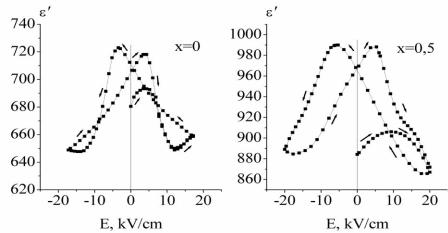
Figure. Reversive dependences of ( =) in (1−x)Ba0.95Pb0.05TiO3+xCo2O3 compounds (x = 0 and 0.5 wt%) at T = 25 ˚
Increasing the cobalt content (Co>0.5 wt%) leads to a significant smearing of the maximum ( =) at Ec, which agrees well with the behavior of temperature dependences (T) in the region of the ferroelectric phase transition [3]. There was found that modifying by admixture of Co to change substantially the thermal anomalies of dielectric properties and shift the
ferroelectric phase transition temperature.
The nature of the dielectric response '(T) in (1−x)Ba0.95Pb0.05TiO3+xCo2O3 compositions have shown that the phase transition at x>0.5 wt% becomes substantially diffused, and can be described in the framework of existing approaches to the relaxation of polarisation in ferroelectrics with diffuse phase transition.
The obtained results are interpreted within the framework of the contribution of domain and phase boundaries to the processes of polarization and depolarization with different arrangement of the structure of the ferroelectric material under study.
The authors are grateful to A. Kalvane for the synthesis of the samples.
References
1. Haertling G.H. Ferroelectric ceramics: history and technology / G.H. Haertling // Journal of the American Ceramic Society. – 1999. – V. 82. - № 4. - P. 797–818.
2. Drougard . . Domain clamping effect in barium titanate single crystals / . Drougard, D.R.Joung // Phys. Rev. – 1954. - № 6. - P. 1561–1566.
3. Bormanis K. Dielectric and acoustic properties of modified barium titanate ceramics / K.
Bormanis, A. Kalvane, A. I. Burkhanov, L. Eglite and R. V. Dikov // Ferroelectrics. – 2019. - V. 538. - № 1. - P. 12–19.
DOI: 10.1080/00150193.2019.1569980.
UDC 537.226.4
RELAXATION OF NONEQUILIBRIUM DOMAIN STRUCTURE OF TRIGLYCINE SULFATE NEAR THE CURIE POINT
O.M.Golitsyna1, S.N.Drozhdin2, V.O.Lesnikova3
1Candidate of Physical and Mathematical Sciences, Associate Professor,
golitsynaom@yandex.ru
2Doctor of Physics and Mathematics, Professor, drozhdin@phys.vsu.ru
3 Assistent, chulakovavo@mail.ru
1,2Voronezh State University
3Voronezh State Medical University
Relaxation of the non-equilibrium domain structure of a ferroelectric crystal triglycine sulfate (TGS) rejuvenated by a short-term exposure in the paraelectric phase was studied in the temperature
75
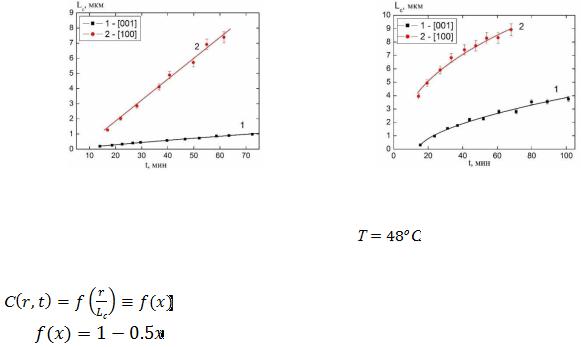
range |
= 1 near the Curie point TC. The domain structure had been observed by means of AFM |
technique.
Keywords: triglycine sulfate, Curie point, non-equilibrium domain structure, relaxation, correlation length, scaling.
Relaxation of the non-equilibrium 1800-th domain structure emergent at the ferroelectric phase transition of the 2-nd order can be described using the ideas developed for the analysis of the ordering dynamics of two-phase systems described by the scalar order parameter [1].
In this paper, the relaxation of DS, visualized in ferroelectric crystal TGS by means of
AFM technique in the temperature interval TC ˗ 1 ≤ < TC was investigated. Before these measurements, the aged samples were "rejuvenated" by exposure for 30 min at T = 60 ° C and
as a result a fine striped domain structure [2] emerged initially in the ferroelectric phase just near TC. Over time the enlargement of the domain structure occurs. This process is rather complicated and involves the various stages of transformation of the domain pattern.
Earlier studies were carried out, either by nematic liquid crystals for lenticular domain structure [3], or at a much greater distance from the TC [4].
A quantitative description of the evolution of two-phase systems is carried out usually
using a space-time correlation function of the macroscopic order parameter K(r,t) = < (r, t )
(r , t )>, from which the characteristic length LC(t) can be determined. According to [1], the dependences LC(t) are power-law:  (t)
(t) , where α = 0,5 for the non-conserved or-
, where α = 0,5 for the non-conserved or-
der parameter and α = 0,3 - for the conserved one.
As a result of the studies was found the following:
1) the characteristic length Lc increases with time according to the power law Lc(t) ~ t α (Fig.1); the decrease of the absolute values of the exponent α on the lowering of a temperature from TC in the temperature range under study is a consequence of the transition of the domain structure during its evolution from the non-conservative state to the conservative one;
a) |
b) |
Fig. 1. The time dependences of the characteristic length for pure TGS: a) at a temperature  along the crystallographic directions [001] and [100];
along the crystallographic directions [001] and [100];
|
b) the same at a temperature |
2) the |
correlation functions, presented for different time moments as dependences |
|
, have near the temperature of ferroelectric phase transition the |
form |
(for 0 ≤ x ≤ 2), which is the universal for ordering kinetics of two- |
phase systems with scalar order parameter (Fig.2).
76

Fig. 2. Dependences |
for the time moments from 2 to 80 min for C = 1 , along |
|
the crystallographic direction [001] |
References
1.A. J. Bray. Theory of phase-ordering kinetics / Advances in Phys. – 1994. – V. 43. – № 3. – P. 357-459.
2.K.Takahashi, M.Takagi. Topographic study of domain boundaries in TGS.1/ Journal of the Physical Society of Japan, 1978. – V.44. – 4. – P.1266-1274.
3.N. Tomita, H. Orihara, Y. Ishibashi. Ferroelectric domain pattern evolution in quenched triglycinesulphate / Journal of the Physical Society of Japan, 1989. – V. 58. – № 4. – P. 1190-1198.
4.V. Likodimos, V. Labardi, M. Allegrini. Kinetics of ferroelectric domains investigated by scanning force microscopy / Physical Review B. – 2000. – V. 61. – № 21. – P. 14440-14447.
UDC 537.226.4
EFFECT OF STATIC MAGNETIC FIELD ON THE DIELECTRIC
AND FERROELECTRIC PARAMETERS OF TRIGLYCINE SULFATE CRYSTAL
O.M.Golitsyna1, S.N.Drozhdin2, A.Yu.Lun3
1 Candidate of Physical and Mathematical Sciences, Associate Professor, golitsynaom@yandex.ru 2Doctor of Physics and Mathematics, Professor, drozhdin@phys.vsu.ru
3Graduate Student, asder793@mail.ru Voronezh State University
The influnce of weak static magnetic field on the nominally pure ferroelectric crystal triglycine sulphate (TGS), which depends on the mutual orientation of the vectors of magnetic induction and spontaneous polarization, leads to a long lasting and non-monotonic change of the dielectric permittivity, the tangent of the dielectric loss angle, the coercive field and the spontaneous polarization of the crystal.
Keywords: static magnetic field, ferroelectric tryglycine sulphate crystal.
The effect of the magnetic field on ferroelectric crystals leads to certain changes in their electrophysical properties [1-3], but the insufficiently studied mechanisms of these phenomena are currently unclear, that requires further research.
In the present work the influence of weak static magnetic field (permanent magnet, B = 0,3 T, exposure time 30 minutes) on the dielectric permittivity , the tangent of dielectric loss angle tg , the coercive field, EC, the spontaneous polarization PS of nominally pure triglycine sulfate ( TGS) - chemical formula (NH2CH2COOH)3•H2SO4 -uniaxial ferroelectric crystal with the model second order ferroelectric phase transition at a temperature TC = 49 oC
had been studied.
Measurements of these parameters were carried out in the temperature range from 20 ° C to 47 ° C. The influence of the magnetic field on the value of the Curie temperature TC was
also studied.
The following regularities were established.
77
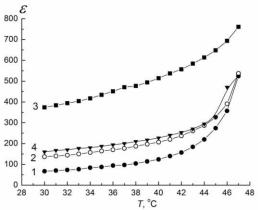
1)The magnetic effect is essentially anisotropic and depends on the mutual orientation of the vectors B and PS : the effect is completely absent when the vectors B and PS are collinear; it is most strongly expressed when B and PS are mutually orthogonal and the magnetic field is oriented along the crystal axis a. The effect is considerably weaker if the magnetic field is oriented along the crystal axis c.
2)The temporal behavior of the studied parameters is non-monotonous after exposure of the crystal in the magnetic field: after removal of the sample from the magnetic field a significant increase of the values of , a small increase of the values of PS and a decrease of the values of the EC take place initially. After about 30 hours these parameters reach their extreme values, and after that a long (tens of hours) restoration of their original values occurs (Figure).
Figure. Temperature dependences of the dielectric permittivity : 1 – before placing
the sample in a magnetic field; 2 – through t = 0.5 h; 3 – through t =30 h; 4 – through t =168 h after removal of the sample from the field
3) At a simultaneous action on a crystal of magnetic field and of electric field E collinear to PS (E = 2EC) the observed effects are expressed more strongly in case of the ac electric field E~ , instead of dc field E= .
The relaxation nature of the observed effects, as well as the influence of the electric field on them, may point to the participation of the charge and defect subsystems of the crystal and of its domain structure in the processes under study.
References
1.Golovin Yu. I. Magnetic Plasticity of Solids / Physics of the Solid State.- 2004.- Vol. 46.- B. 5.- P. 769-803.
2.Levin, M. N., Postnikov V. V., Palagin, M. Y. The Influence of weak pulsed magnetic fields on crystals of triglycine sulfate / Physics of the Solid State.- 2003.- Vol. 45.- B. 3.- P. 513-517.
3.Yakushkin E. D. Dielectric response of a uniaxial ferroelectric in a magnetic field / JETP Letters.- 2014.- Vol. 99.- B. 7.- P. 483-487.
538.9 |
|
|
|
|
Ё |
|
|
|
|
|
|
LiNbO3 |
|
|
. . |
1, . . |
2, . . |
|
3 |
|
1 |
|
|
|
, dybovvlad@gmail.com |
||
|
|
|
|
|||
|
2 |
|
|
, dmitry.tut@mail.ru |
||
|
|
|
|
|||
3 |
.- |
. |
, |
, ekbelonogov@mail.ru |
||
|
||||||
|
« |
|
|
|
|
» |
|
, |
|
|
Li-Nb-O, |
LiNbO3 |
- |
NiSi/Si |
|
|
|
|
550° |
|
|
|
|
LiNbO3 |
|
|
. |
LiNbO3 |
|
|
|
NiSi/Si |
550° |
- |
78

|
, |
|
- |
LiNbO3; |
|
- |
|
[000.1]. |
|
|
|
|
|
|
: |
, |
|
|
, |
. |
|
|
|
- |
|
|
- |
|
|
. |
– |
|
|
- |
|
|
|
|
|
Si. |
|
NiSi |
(111) Si |
|
|
|
|
|
550° |
. |
|
Li-Nb-O |
0,1 |
0,2 |
- |
|
|
|
|
( |
) |
- |
|
|
|
(550° |
) |
|
- |
|
|
|
|
( |
NiSi/Si), |
- |
|
|
|
|
|
. |
- |
|
|
|
|
|
( -100 , |
- |
« |
»). |
, |
|
, |
|
- |
( ) |
|
550ºC |
|
1 |
. |
|
. |
|
|
Li-Nb-O, |
|
|
|
|
|
|
550 ° |
NiSi/Si |
|
|
, |
|
|
|
LiNbO3 |
|
- |
NiSi/Si |
|
|
Li-Nb-O, |
|
|
|
550° |
|
|
LiNbO3 |
|
|
- |
. |
|
|
|
|
|
550 |
° |
|
LiNbO3 |
, |
|
NiSi/Si |
|
|
|
|
|
- |
||
LiNbO3; |
|
|
[000.1]. |
№ 18-29-11062 |
||
). |
|
|
|
( |
||
|
|
|
|
|
|
|
538.95 |
|
|
|
|
|
|
|
|
|
BiNi0.67Sb0.33O3 |
|
|
|
|
. . |
1, |
. . |
2 |
|
|
1 - |
.- . |
, |
, s_gridnev@mail.ru |
|
|
|
|
2 |
, kobyakov.vania@yandex.ru |
|
|
||
« |
|
» |
|
|||
|
|
|
|
|
||
|
500 |
1 |
|
|
|
|
79
